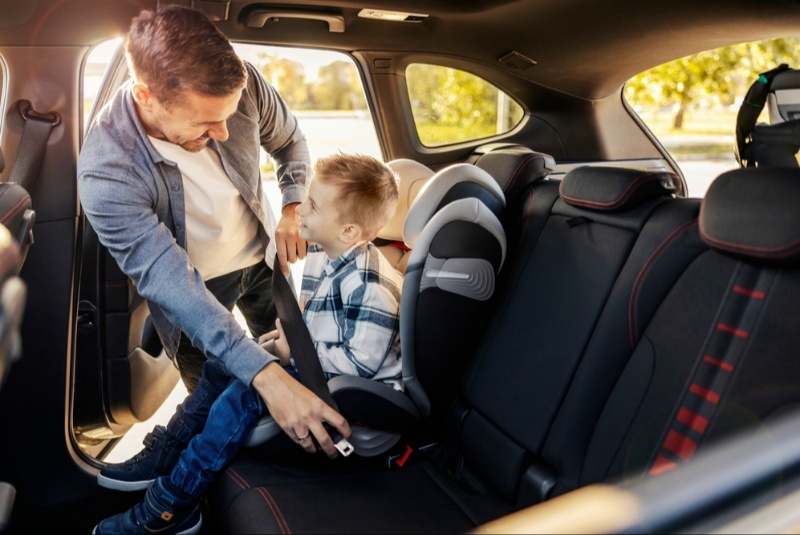Selecting the right car seat for your child is one of the most crucial decisions you will make as a parent. A car seat is not just a piece of equipment to make car rides more convenient; it's a critical safety device that can save your child's life in the event of a collision. This guide aims to navigate you through the process, emphasizing the importance of safety first. We'll cover key factors such as understanding different types of car seats, ensuring the car seat fits your child and vehicle, installation tips, and keeping up with car seat laws and recommendations.
Understanding Different Types of Car Seats
Car seats are categorized based on age, weight, and height of the child. They range from rear-facing infant seats, convertible seats, all-in-one seats, to booster seats for older children. Rear-facing seats are the safest for young children, as they provide the best support for the head, neck, and spine in a crash. Convertible seats can transition from rear-facing to forward-facing, accommodating growing children. All-in-one seats offer a long-term solution, converting from a rear-facing infant seat to a booster seat. Finally, booster seats are for children who have outgrown forward-facing seats, raising them to the proper height for the car's seat belt. Understanding these types will help you select a seat that fits your child's current stage and can grow with them.
Ensuring the Car Seat Fits Your Child and Vehicle
A car seat must fit your child's current size while also being compatible with your vehicle. Start by checking the car seat's weight and height limits to ensure it's suitable for your child. Then, consider your vehicle's size and whether the car seat can be securely installed. Not all car seats fit well in all cars, so it's essential to check the compatibility. Many car seat manufacturers provide lists of compatible vehicles, or you may need to try installing the car seat in your car before purchasing. Remember, the best car seat is the one that fits your child, your vehicle, and can be used correctly every time.
Installation Tips for Maximum Safety
Proper installation of the car seat is paramount to ensuring its effectiveness in a crash. Always refer to the car seat's instruction manual as well as your vehicle's owner manual regarding the use of car seats. Most new cars and car seats use the LATCH system (Lower Anchors and Tethers for Children), which is designed to make installation easier. However, using the vehicle's seat belt to secure the car seat is also an option and may be necessary for older cars. After installation, the car seat should not move more than an inch side-to-side
or front-to-back when pulled at the belt path. If you're unsure about the installation, many local fire departments, police stations, and hospitals offer free car seat checks by certified technicians.
Staying Updated with Car Seat Laws and Recommendations
Car seat laws vary by state and country but generally outline the minimum requirements for children's use of car seats and booster seats. It's crucial to familiarize yourself with the laws applicable in your area to ensure compliance. However, safety recommendations from organizations such as the American Academy of Pediatrics often go beyond legal requirements, advising parents on best practices for keeping children safe in vehicles. For example, keeping children in rear-facing seats until at least age 2, or for as long as possible within the seat's limits, is a recommendation based on research showing the increased safety of rear-facing positions.

Considering Ease of Use and Comfort
While safety is the paramount concern when selecting a car seat, ease of use and comfort are also important. A car seat that is difficult to install or adjust is more likely to be used incorrectly, which can compromise its safety. Look for car seats with clear, user-friendly instructions and features that simplify adjustments, such as no-rethread harnesses and multiple recline positions. Comfort features such as padded straps, breathable fabrics, and adequate head support can make car rides more enjoyable for your child, especially during long trips.
The Importance of a Proper Fit Over Time
Children grow quickly, and their car seat needs can change just as fast. A car seat that once fit your child perfectly might become too small or unsuitable for their development stage. Regularly check that your child has not surpassed the car seat’s weight or height limits. Additionally, evaluate the fit of the harness and the position of the headrest as your child grows. Convertible and all-in-one car seats that adjust to fit children as they grow can offer a cost-effective solution to this challenge, providing a proper fit through multiple stages of your child's development.
When to Replace a Car Seat
Knowing when to replace a car seat is critical for maintaining safety. Car seats have expiration dates, typically ranging from six to ten years from the date of manufacture, due to the degradation of materials over time. Always check the expiration date on your car seat and plan for a replacement accordingly. Additionally, car seats that
have been in a moderate to severe crash should be replaced, even if there’s no visible damage, as their integrity could be compromised. Manufacturers may provide specific guidelines on what constitutes a crash severe enough to necessitate replacement. It’s also wise to replace a car seat if it has missing parts, is damaged, or if there have been recalls on the model.
Researching and Reading Reviews
With the vast array of car seat options available, it’s beneficial to conduct thorough research and read reviews from other parents and safety organizations. Reviews can provide insight into the real-world functionality of car seats, including ease of installation, comfort, and durability. Safety ratings and crash test results, often available through consumer advocacy groups and government agencies, offer an objective look at a car seat’s performance in simulated crash scenarios. Utilizing these resources can help you make an informed decision backed by evidence and community feedback.
Trying Before Buying
If possible, try installing the car seat in your vehicle before making a purchase. Some baby stores offer demonstration models specifically for this purpose. This trial can help you assess the fit in your car, the ease of installation, and whether the car seat meets your expectations for quality and ease of use. If you can't try before you buy, ensure that the retailer has a flexible return policy in case the car seat doesn’t fit your vehicle as expected or if you encounter any issues.
Budget Considerations
While it’s crucial not to compromise on safety for the sake of cost, budget considerations are a reality for many families. High price tags do not always equate to higher safety. Many affordable car seats meet and exceed safety standards. Focus on finding a car seat that offers the essential safety features required for your child’s age, weight, and height, without unnecessary extras that may inflate the price. Additionally, consider investing in a convertible or all-in-one car seat that can adapt to your child’s growing needs, potentially saving money in the long run.
Selecting the right car seat for your child involves careful consideration of safety features, suitability for your child and vehicle, ease of installation and use, and budget. By staying informed about car seat types, safety standards, and best practices, you can make a choice that ensures your child’s safety and comfort on the road. Remember, the best car seat is the one that fits your child, your vehicle, and is correctly used every time you drive. With the right approach and knowledge, you can find a car seat that offers peace of mind, knowing that your child is secure whenever you're on the move.




